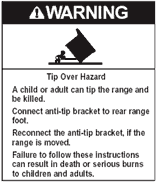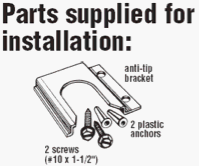We often find freestanding ranges that do not have an Anti-tip device. Many clients may feel that reporting this device as missing is being "picky" but it is a clear safety hazard. Anti-tip brackets are metal devices designed to prevent freestanding ranges from tipping. They are normally attached to a rear leg of the range or screwed into the wall behind the range, and are included in all installation kits. A unit that is not equipped with these devices may tip over if enough weight is applied to its open door, such as that from a large Thanksgiving turkey, or even a small child. A falling range can crush, scald, or burn anyone caught beneath.
Bracket Inspection
During an inspection, we can confirm the presence of anti-tip brackets through the following methods:
- It may be possible to see a wall-mounted bracket by looking over the rear of the range. Although a visual confirmation does not guarantee that the bracket has been properly installed. Because of this we only do the visual inspection if the range is too heavy to perform the next method.
- We firmly grip the upper-rear section of the range and tip the unit and pull it toward the front to manually tip the range. If equipped with an anti-tip bracket, the unit will not tip more than several inches before coming to a halt. The range will be turned off, and all items removed from the stovetop before this action can be performed. It is usually easy to detect a bracket by tipping the range. This test can also confirm the functionality of a bracket where the visual inspection cannot confirm functionality.
If no anti-tip bracket is detected,we note it on the report.
Clients can contact the dealer or builder who installed their range and request that they install a bracket. For clients who wish to install a bracket themselves, the part can be purchased at most hardware stores or ordered from a manufacturer. General Electric will send their customers an anti-tip bracket for free.
According to the U.S. Consumer Product Safety Commission (CPSC), From 1980 through 2008, CPSC staff is aware of 38 fatalities associated with range tipovers. Twenty (53 percent) of these range tipover fatalities involved children aged one year to five years old. From January 1, 1980 through December 31, 2006, CPSC staff is aware of 84 injuries. The majority of injuries, regardless of age, were burns suffered when hot liquids spilled from the pots or pans that tipped when the range tilted. A small child may stand on an open range door in order to see what is cooking on the stovetop and accidentally cause the entire unit to fall on top of him, along with whatever hot items may have been cooking on the stovetop. The elderly, too, may be injured while using the range for support while cleaning.
In response to this danger, the American National Standards Institute (ANSI) and Underwriters Laboratories (UL) created standards in 1991 that require all ranges manufactured after that year to be capable of remaining stable while supporting 250 pounds of weight on their open doors. Manufacturers' instructions, too, require that anti-tip brackets provided be installed. Despite these warnings, retailer Sears estimated in 1999 that a mere 5% of the gas and electric units they sold were ever equipped with anti-tip brackets. As a result of Sears’ failure to comply with safety regulations, they were sued and subsequently required to secure ranges in nearly 4 million homes, a measure that has been speculated to have cost Sears as much as $500 million.
In summary, ranges are susceptible to tipping if they are not equipped with anti-tip brackets. This is why we confirm that these safety devices are present and report it when they are not present.






